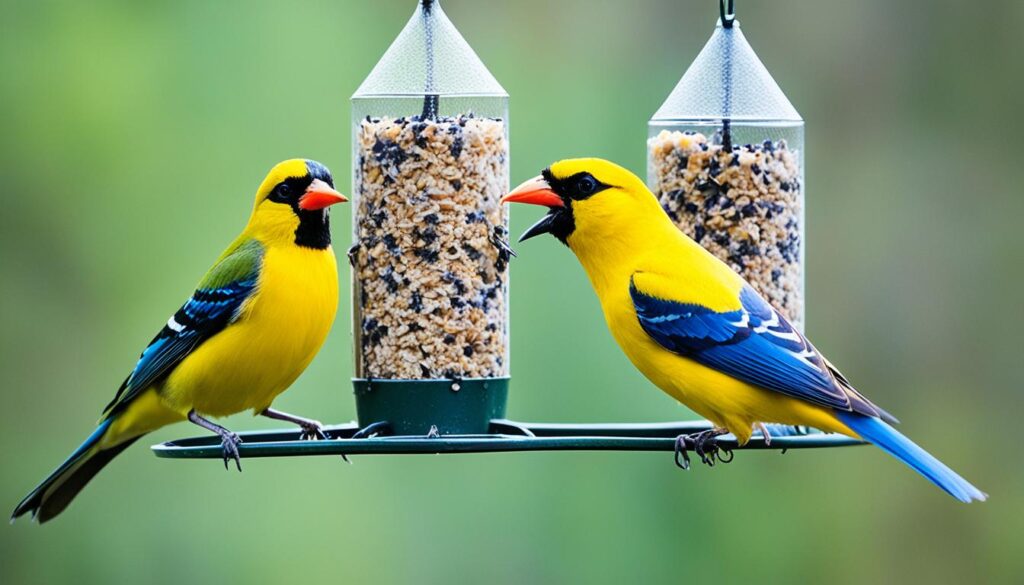As autumn arrives, bringing cool air and colorful leaves, backyard bird feeders start to fill up. Suet, a tasty, high-energy food, is a big hit. It draws in many birds, like woodpeckers and nuthatches.
Suet is a solid fat food that birds love all year, but it’s especially important in the cold months. It gives them the calories they need to stay warm and active. By putting suet out, you can watch a variety of interesting birds visit your yard.
Key Takeaways
- Suet attracts a wide range of bird species, including woodpeckers, chickadees, nuthatches, and more.
- Suet is especially beneficial in the fall and winter when birds need extra calories to stay warm.
- Offering suet in your backyard can help draw in a diverse array of feathered visitors.
- Suet comes in various forms, such as cakes, doughs, and balls, to suit different bird preferences.
- Properly placed and maintained suet feeders can deter squirrels and other unwanted visitors.
Introduction to Suet as Bird Food
Suet comes from the hard fat around beef and mutton kidneys and loins. It’s a key food for many backyard birds. This food is easy for birds to digest and use for energy, especially in winter.
Importance of Suet in a Bird’s Diet
Suet is vital for birds. It gives them the nutrients they need and helps them get ready for winter. Birds eat suet to build up fat reserves. These reserves help them when food is scarce or hard to find.
Benefits of Offering Suet to Backyard Birds
Feeding suet to birds has many benefits. It gives them a lot of energy and supports their nutrition. Many birds like it, including woodpeckers, nuthatches, chickadees, and others. This makes suet a great way to attract different birds to your yard.
“Suet is a valuable addition to any backyard bird feeding station, providing essential calories and nutrients to help sustain our feathered friends through the winter months.”
You can buy suet cakes or make your own. Adding suet to your bird feed is good for you and the birds. It’s a rewarding way to help your local birds.
Birds That Commonly Eat Suet
Suet is a high-energy food made from rendered fat. It attracts many backyard birds. Woodpeckers, nuthatches, and chickadees are often seen at suet feeders.
Woodpeckers
Woodpeckers like the Downy, Hairy, Red-bellied, and Northern Flicker enjoy suet’s rich fat. They use their strong beaks to get to the nutrients. In winter, they need extra calories to stay warm.
Nuthatches
Nuthatches, like the White-breasted and Red-breasted, love suet too. They can be seen on suet feeders, pecking away. Their ability to climb down trees head-first helps them get to the suet.
Chickadees
Chickadees, including the Black-capped and Carolina types, adore suet. These small birds visit suet feeders often, taking turns to eat. They eat a lot of suet in winter to keep their energy up.
Putting suet in your backyard draws in many birds. You’ll see woodpeckers, nuthatches, and chickadees. Suet gives them the fats and calories they need to survive the cold.
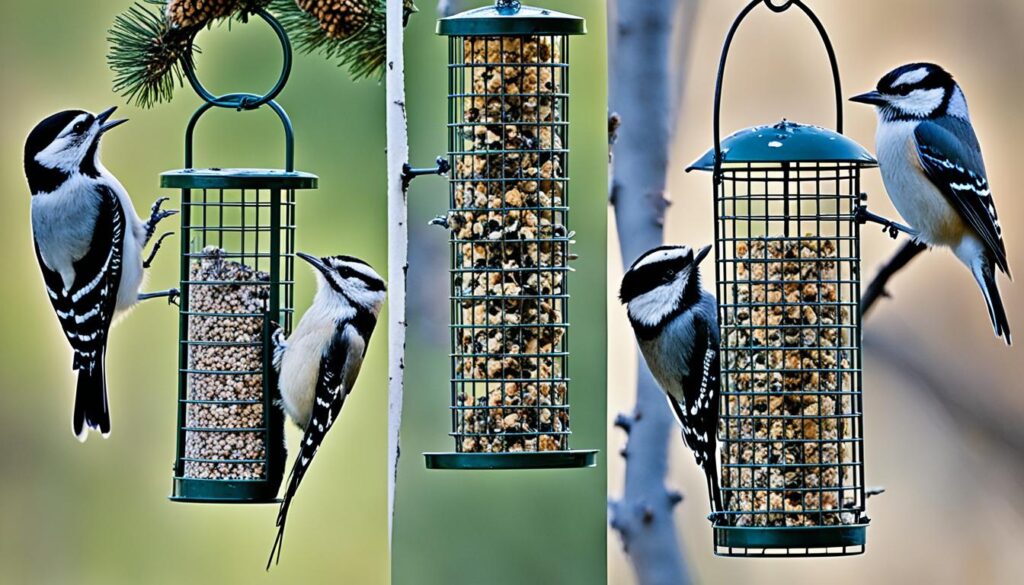
What birds eat suet?
Suet is a rich, nutritious bird food that draws in many backyard birds. It’s not just for woodpeckers, nuthatches, and chickadees. Wrens, creepers, kinglets, jays, starlings, warblers, thrashers, and goldfinches also love suet. Its high calorie content makes it a great choice for any bird feeder.
Woodpeckers, nuthatches, and chickadees are big fans of suet. But, other birds come to enjoy it too, especially when it’s cold and finding food is hard.
- Wrens and creepers eat suet to add to their diet of insects.
- Kinglets, being small and busy, can’t resist suet as a food source.
- Jays and starlings, being bigger and more bold, often take over suet feeders. Watching them can be fun.
- Occasionally, warblers, thrashers, or goldfinches might show up at your suet feeder, adding to the variety of backyard birds you attract with bird food.
Offering suet helps meet the needs of your birds during the winter bird feeding season. It also lets you enjoy the colorful bird feeders in your yard.
“Suet is a versatile and nutrient-dense food that appeals to a wide range of feathered visitors, making it a valuable addition to any backyard bird feeding station.”
Attracting a Variety of Birds with Suet
To attract many birds to your yard, pick the right suet feeders and place them well. Choose metal suet feeders over plastic ones because they last longer and squirrels can’t easily damage them. Feeders with cages or baffles keep pests away, letting birds enjoy the food without trouble.
Choosing the Right Suet Feeder
Look for suet feeders that welcome different bird types. Some have special compartments or perches for various birds to eat at once. Also, feeders with mesh or wire cages keep suet fresh and squirrels out.
Placement and Location of Suet Feeders
Where you put your suet feeders matters a lot. Place them near trees or shrubs for birds to feel safe and get to the suet easily. Don’t put them in the sun as it can melt the suet. Having several suet feeders around can bring in more bird species, like woodpeckers, nuthatches, chickadees, and jays.
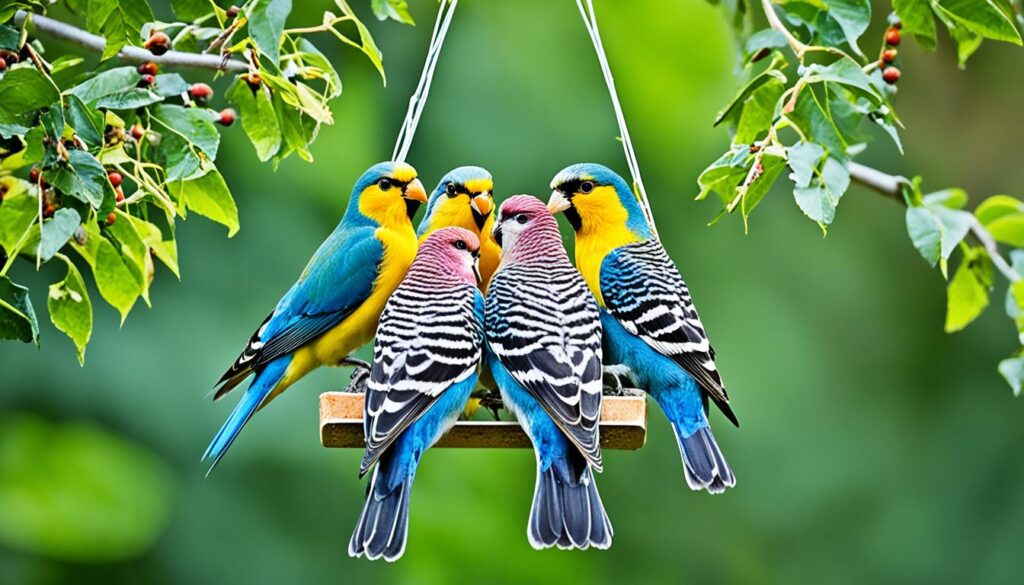
“Offering a variety of suet feeders in different locations can help you attract the widest range of bird species to your backyard.”
By picking the best suet feeders and placing them right, you can make your yard a haven for birds. This makes your outdoor time better and helps the local wildlife.
Homemade Suet Recipes
Many birders prefer making their own suet at home. This way, they can offer a healthier and tastier option to birds. Homemade suet mixes can draw in more birds to your yard.
Simple Suet Cake Recipe
To make a basic suet cake, mix suet or bird-safe fats with cornmeal, peanuts, dried fruits, or birdseed. Avoid adding too much sugar, as it can be bad for some birds. Aim for a mix that’s full of nutrients to help your bird friends.
Nutrient-Rich Suet Mixes
- Peanut Butter Suet: Mix suet, peanut butter, seeds, nuts, and dried insects for a high-protein snack.
- Fruit and Nut Suet: Add chopped dried fruits, unsalted nuts, and whole grain flour for a balanced mix.
- Insect-Infused Suet: Use dried mealworms or other insects to attract insect-eating birds.
Make sure your homemade suet is mold-free and fresh. Store any leftovers in the freezer to keep it good. This way, you can feed your birds safely and effectively.
“Feeding birds with homemade suet is a rewarding way to attract a diverse array of feathered visitors to your backyard. The creative possibilities are endless!”
Suet Feeder Maintenance
Keeping your suet feeders clean and fresh is key to attracting birds to your yard. It’s important to clean and refresh the suet often. This keeps your backyard birds happy and healthy.
Cleaning Suet Feeders
Old or moldy suet can build up in your feeders, making them less safe for birds. Here’s how to keep your feeders clean:
- Take the feeder down and take it apart if you can.
- Wash it with mild soap and water, cleaning off any dirt.
- Let it dry completely before putting it back together and filling it up.
Refreshing Suet
It’s also crucial to replace the suet regularly. If the suet is soft, melted, or looks bad, it’s time for a change.
- Check your feeders often and swap out any old or bad suet.
- Use top-quality suet cakes or make your own to feed the birds well.
By taking care of your suet feeders, you help birds visit and enjoy this important food source. This is especially true in the cold months when other food is scarce.
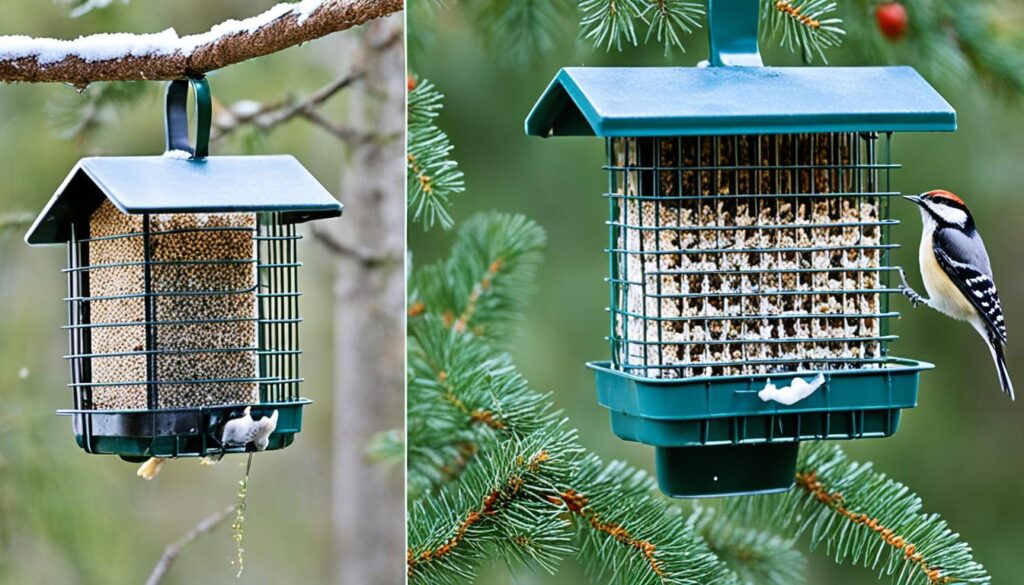
“Properly maintained suet feeders are a crucial part of providing a healthy and welcoming habitat for our feathered friends.”
Seasonal Considerations for Offering Suet
Suet can be given to birds all year, but think about the seasons. In fall and winter, suet helps birds keep warm and energized. But, don’t leave suet out in very hot weather because it can melt and spoil, hurting the birds.
If it’s often over 90°F where you live, wait to give suet until it cools down. This way, you make sure birds get suet when they really need it.
In spring and summer, mix suet with seeds, fruits, and other nutrients. This meets the changing needs of birds as they nest, breed, and care for their young. Offering seasonal suet brings different birds to your yard all year.
Knowing what winter bird feeding and suet in hot weather birds need helps you help them. Giving year-round suet suited for each season is a great way to support local birds.
Squirrel-Proofing Your Suet Feeders
Squirrels love to raid suet feeders, eating the high-fat treats meant for birds. To stop them and keep the suet for the birds, use squirrel-proof suet feeders. These feeders have cages or baffles that let small birds in but keep squirrels out.
Baffles and Cages for Suet Feeders
Baffles and cages on suet feeders are great at protecting suet from squirrels. They make it hard for squirrels to get to the suet. A good, squirrel-resistant suet feeder lets birds enjoy the suet without squirrels bothering them.
- Squirrels can jump up to 8-10 feet horizontally, so place suet feeders carefully.
- A well-placed baffle can stop squirrels from getting to the suet, even if the feeder is near a high branch.
- Caged suet feeders are also a good way to protect suet from squirrels.
Using squirrel-proof suet feeders in your backyard makes it a better place for birds. It also keeps those pesky squirrels away.
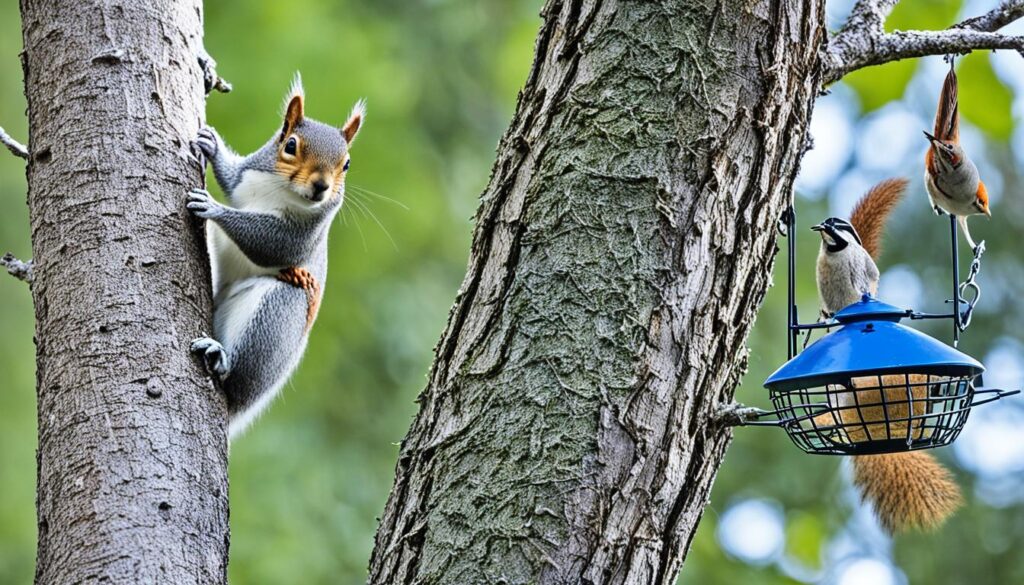
“The right baffle and careful positioning of the suet feeder on baffled poles can effectively deter squirrels from accessing suet feeders.”
Frequently Asked Questions About Suet
Suet is a favorite food for backyard birds, leading to many questions from bird lovers. Let’s look at some common questions about suet feeding and give answers.
What is Suet?
Suet is a high-energy food made with animal fat. It comes in cakes, balls, or bricks. It’s key for many birds, especially when food is hard to find in the cold months.
What Birds Eat Suet?
- Woodpeckers (Downy, Hairy, Red-bellied, Pileated)
- Nuthatches (White-breasted, Red-breasted)
- Chickadees (Black-capped, Carolina)
- Flickers, Starlings, Wrens, Warblers, Blue Jays, Thrushes, and more
When Should I Offer Suet to Birds?
You can feed suet to birds all year, but it’s best in the cold months. Birds need high-calorie food early in the morning and at night. Suet is perfect for their needs.
How Do I Attract a Variety of Birds with Suet?
To get different birds, try suet with various flavors like peanut, papaya, or hot pepper. Use feeders in good spots and ones that keep squirrels out. This will attract more birds.
“Suet is a high-energy food, especially valuable in cold weather, as it provides the calories birds need to survive the winter.”
Feeding suet is a great way to watch and enjoy backyard birds. By knowing the answers to these questions, you can meet your birds’ dietary needs better.
Fun Facts and Trivia About Suet Feeding
Feeding suet to backyard birds is a fun activity that shows us how amazing they are. Birds eat a lot and have clever ways to get food. There’s lots of interesting facts about suet feeding to learn.
Did you know wild birds can eat twice their weight in food daily? That’s amazing, especially since suet is a high-energy food. It helps them survive the winter. In places like Big Bear Lake, suet is crucial for their energy.
- Suet is also key in spring to help birds rebuild their energy after winter.
- In summer, birds might not visit feeders much because they find plenty of food on their own. But in fall, they need high-calorie foods like suet for their migration.
Birds get about 25% of their food from feeders and the rest from nature. But suet is still very important. Some birds, like the Baltimore oriole, eat up to 17 caterpillars a minute. House wrens can eat up to 500 spiders a day!
The shape of a bird’s beak tells us a lot about what it eats. Hooked beaks are for hunting, and cone-shaped beaks crack nuts and seeds. Bird-feeding is the second biggest hobby in the U.S., after golf.
“Birds need calcium, especially before they mate or migrate. Not all birds can find calcium easily. Adding crushed eggshells to their food can really help.”
So, when you’re filling your suet feeder, remember the amazing world of backyard bird feeding. These birds have different eating habits and nutritional needs. There’s always more to learn about them.
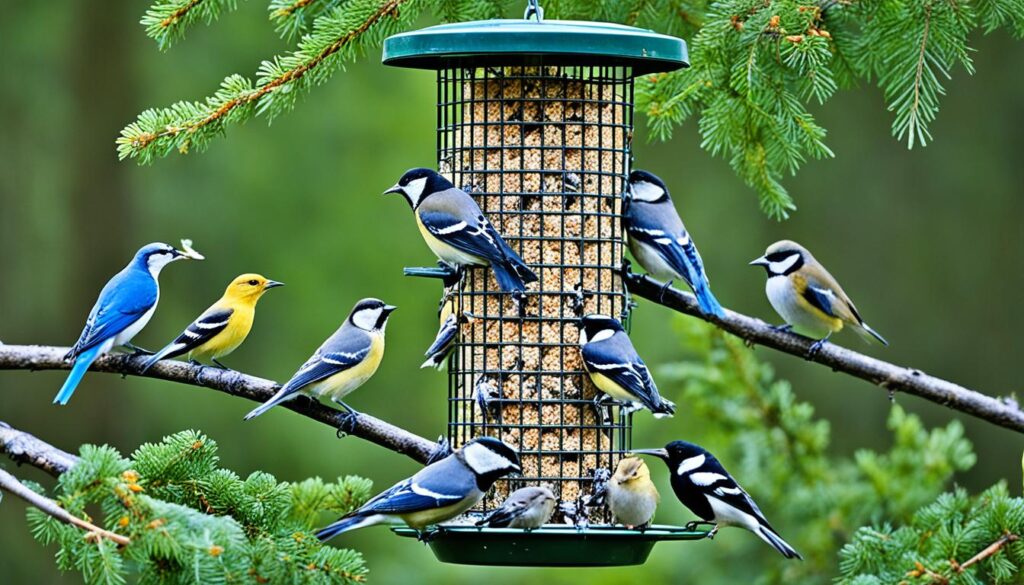
Comparison: Suet vs. Other Bird Foods
Suet is a special food for birds, especially in the cold. It’s full of fat and calories, giving birds the energy they need to stay warm. This makes suet a key food for winter.
Many birds like suet, including woodpeckers, nuthatches, and chickadees. These birds might not visit seed or fruit feeders as much. Suet is a top choice for many bird lovers.
Seeds, Nuts, and Fruits
Seeds, nuts, and fruits are great for birds. But they might not give birds the fat and calories they need in winter. Suet is a better choice for giving birds the energy they require.
Mealworms and Insects
Mealworms and insects are high in protein but might not be as easy to get as suet. Suet is easy to use and gives birds what they need to stay healthy.
“Suet is a crucial component of a well-rounded bird feeding program, offering birds the high-energy boost they need to thrive, especially during the coldest months.”
Safety Precautions for Feeding Suet
Suet is a safe and healthy food for birds, but we must be careful. It can become rancid or develop mold if not stored right. Feeding birds suet that’s gone bad can harm their health. So, it’s important to check the suet often and replace it if it’s not fresh.
Proper suet storage is crucial for keeping this treat safe and fresh for birds. Keep suet in an airtight container in a cool, dry spot. This helps keep the suet fresh and safe for birds to eat.
Avoiding Rancid or Moldy Suet
- Throw away any suet that looks bad, smells bad, or crumbles easily. These are signs it’s gone bad.
- Don’t put suet feeders in direct sunlight or high heat. This can make the suet melt and spoil fast.
- Change suet cakes once a week, especially when it’s warm. This stops bacteria and mold from growing.
By following these easy steps, you can make sure your backyard birds stay safe eating suet. Enjoy watching your birds get healthier on this tasty, safe food.
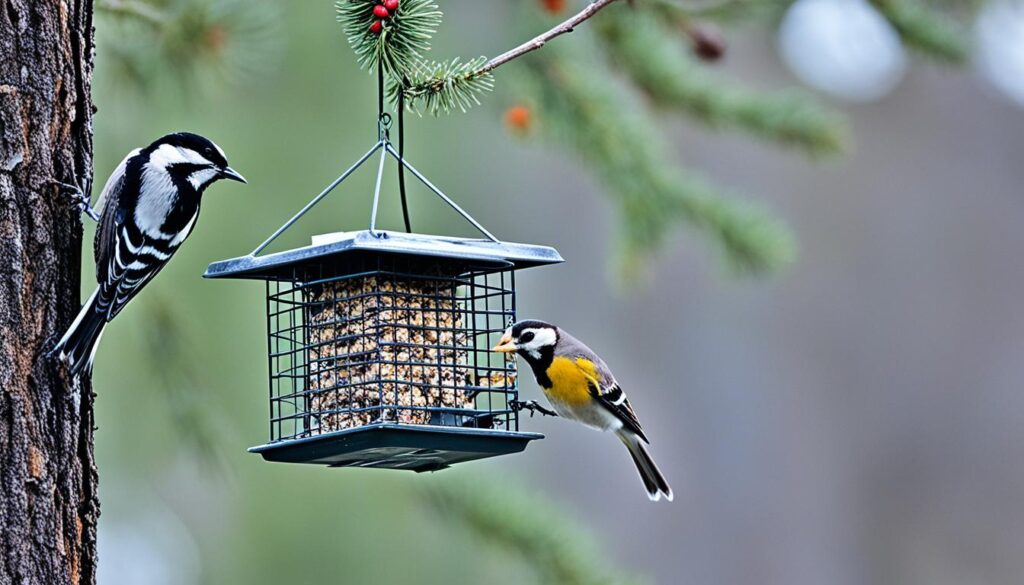
Suet Feeding Tips for Beginners
Feeding suet in your backyard can draw in many birds, like woodpeckers and chickadees. If you’re new to suet feeding, here are some important tips to remember.
Start with a small amount of suet to see which birds come. Then, add more suet as needed. Where you place the suet feeder is also key. Try different spots to see where birds like it best.
- Offer different suet types, like those with nuts, fruits, or insects, to attract more bird species.
- Be patient and keep feeding consistently. It might take time for birds to find and visit your feeder.
- Use metal containers for bird seed to keep out squirrels and mice. Clean your feeders often to stop mold and draw in more birds.
By following these suet feeding tips for beginners, you’ll soon be attracting backyard birds and enjoying winter bird feeding.
“Providing suet is a great way to attract a variety of backyard birds in the cold months. It’s especially good for birds that need it for their energy.”
Conclusion
Feeding suet is a great way to draw many backyard birds to your yard. It gives them the nutrients they need, especially in winter. By picking the right bird feeders and keeping them clean, you make a place where birds can eat well and stay healthy.
Whether you buy suet or make it yourself, it’s a key food for any bird feeding station. It supports your local bird population all year. Offering different suet mixes meets the needs of various bird species, like woodpeckers and chickadees.
Adding suet feeding to your bird-watching hobby is easy and helpful. It helps attract birds and gives them the bird nutrition they need in winter. By placing and maintaining your suet feeders correctly, you make sure birds have a safe, high-quality food source all winter.
FAQ
What types of birds are attracted to suet?
Many birds love suet. This includes woodpeckers, nuthatches, chickadees, wrens, and creepers. Kinglets, jays, starlings, warblers, thrashers, and goldfinches also enjoy it.
Why is suet important for birds, especially in the colder months?
Suet is a high-energy food that birds can easily digest. It gives them the nutrients they need. In winter, it helps them stay warm by providing extra calories.
How can I attract the widest variety of birds to my suet feeders?
Use squirrel-proof metal feeders in different spots around your yard. Try different suet types, like those with nuts, fruits, or insects. This attracts more birds.
What is the best way to make homemade suet cakes?
Mix suet with cornmeal, peanuts, fruits, or dried insects for homemade suet cakes. This makes a nutritious option for birds, better than some store-bought kinds.
How often should I clean and refresh my suet feeders?
Clean suet feeders often to remove old or moldy suet. Wash them with soap and water, then let them dry before refilling. Replace suet if it gets soft or bad to keep the feeder safe for birds.
Are there any seasonal considerations when offering suet to birds?
Offer suet all year, but it’s most helpful in fall and winter. Don’t leave it out in very hot weather, as it can melt and spoil.
How can I deter squirrels from raiding my suet feeders?
Use squirrel-proof feeders with cages or baffles to keep squirrels out. These feeders let small birds in but keep squirrels away.
